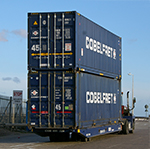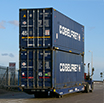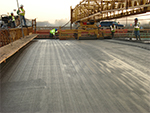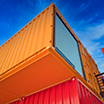

One area where most buyers seem to have a misunderstanding, is how shipping containers are transported and delivered. Unlike most packages you receive from the post office. Your shipping container is not likely going to arrive at your front door. You will need to designate a solid flat area of land. That has enough adequate space for the delivery of your container. Along with the instruments / tools that will be used to make delivery happen. Such as a tilt bed / roll off truck, side loader or crane.
This page is meant to help prepare you for the delivery of your shipping container to your location / site. The process isn’t difficult, although it does require some preparation on your end, to help make the delivery a smooth process. Areas you will definitely want to focus on include providing;
- A stable, level and firm surface
- Enough space for the driver to maneuver
- A clear delivery route
To help minimize any errors that may occur when receiving your shipment. Read below for more insight on the delivery process and what to expect when receiving your container.
Advise Your Local Department of Code Enforcement
Contacting your Department of code Enforcement prior to delivery of your container, is highly recommended. Enforcement codes are different, depending on where you live. Finding out in advance is very important, as it can help eliminate potential delays. Which in the end, if not coordinated properly, could cost you more time and money to complete your delivery.
If the location you are expecting delivery is only temporary. Chances are you will not need a permit. If you plan on leaving it at the delivery site for an extended period of time. Possibly a prefab container home / office. Depending on where you live (Canada, USA, Europe, etc.), a permit will most likely need to be presented.
Disclose Residential or Commercial Site
Before making arrangements to have your container delivered. It’s a good idea to notify the transport company, of whether they will be delivering to a residential site or a commercial site. As stated above. In most cases, when delivering to a residential site. It is required to obtain a permit (or follow HOA regulations) from your city or town, to allow for placement of your container on-site. Most suppliers with experience, should have a good understanding of your area. Therefore, consulting with them is usually not a bad idea.
Another reason to make your supplier aware, is that not all 40′ containers can be delivered to smaller residential areas. Depending on the roads needed to gain access to your destination. There simply may not be enough space for the tractor / trailer to deliver. In this instance, a container that is 20′ or smaller may be your only option. Communicating with your supplier in advance, can help to minimize situations like this, which may delay your delivery. (1)
Who Will Deliver My Order?
We have access to local third party trucking service providers, within the cities we have featured on our website. The driver will communicate with you to help provide a safe delivery to your location. However to be safe, there are a few things that should be taken care of or looked at in advance.
Do You Have Video Of A Delivery?
We have a video example of what you can expect, when you are receiving a delivery of a container. *Coming soon*.
Type of Truck That Will Be Used?


In most situations, you can expect your delivery to arrive via tilt-bed or roll-off truck. Delivery on a flat-bed truck is also possible, permitting that you have your own crane. If for some reason your site does not meet the delivery requirements, laid out in this guide. Feel free to send us an email or give us a call.
Meeting Your Driver
On delivery day. It’s very important that you remain available and accessible, as your driver will call you in advance to make sure everything is ready and good to go.
For safety reasons, the driver will meet with you in advance to inspect the delivery location. Before offloading your delivery. It is also the driver’s responsibility. To decide whether or not your location / site, is safe and accessible for the truck to operate and perform its delivery.
Once the driver has approved the delivery site. They will then begin to offload the container, within the 30 minute time frame that has been provided.
What We Require From You
To do our best at providing as seamless of a delivery process as possible. It is important to make sure that your delivery location is safe for the truck driver to deliver. Plus, has enough space for the driver to maneuver and operate.
In the event that your driver is unable to deliver your container to your preferred location. The driver will offload your delivery to the nearest location possible. If at this point you choose to reject delivery. You will receive a refund of the purchase price, minus a 15% restocking fee and any shipping, trucking, survey, storage and banking fees already incurred.
The requirements below are fairly straightforward. Although it is a good idea to have an understanding of what to expect, before the actual day of delivery.
1. Provide a Clear Delivery Route / No Obstructions
In addition to creating space for your container to be delivered. You will want to make sure that your driver has a clear route, with no obstructions (traffic, steep hills, rocks, low hanging trees, potholes etc.) to reach your destination. Due to the size and weight of the vehicles that are delivering these containers. You will need to do your best to accommodate for their space / footprint, overall mass and turning space. (2)
If you know of any obstacles that may be in your driver’s way, on route to your destination. If you believe that there may be some unstable roads, that can’t withstand the weight during transport. It’s best to communicate those in advance before your driver attempts to make delivery.
Examples of suitable surface paths include; asphalt, concrete, dry compacted gravel or dirt
Examples of unsuitable surface paths include; mud, sand, tall grass, ditches, loose dirt, wet gravel, snow, ice etc.
*Some drivers will not deliver to certain areas without improved roads, where their trucks can maintain good traction.
*Delivery via crane has the potential to be a more affordable option.
2. Provide Enough Space for Operation
In most cases, you will be receiving a 20′ or a 40′ container. 20′ containers generally require around 60′ to 75′ or more of straight clearance. While 40′ containers generally require around 100′ to 150′ or more of straight clearance. Depending on whether you are using a tilt-bed or roll-off truck. To be on the safe side. If receiving a delivery via roll-off truck, do your best to provide 120′ of straight clearance. If receiving via tilt-bed, do your best to provide at least 100′ of straight clearance.
Having enough clearance is not only important for the placement of your container. It’s also important for the safety of your delivery driver. In terms of the sides (or width) of the delivery vehicles and their footprint. A tilt-bed truck requires approximately 10′ of clearance on each side. Where as a roll-off truck requires around 12′ of clearance on each side.
Since most shipping containers available are generally delivered by tilt-bed / roll-off trailers. Another thing to keep in mind when creating space for your delivery is height. If transporting a 20′ or 40′ container. The truck including the container will be at a height of 13’6″. Once at maximum tilt to complete your delivery. The truck including your container can reach a max height of 16′. As a result, it’s good to make sure there are no trees or power lines in the area. This helps avoid any unnecessary obstructions from halting or delaying delivery. (3)
3. Provide a Stable & Firm Delivery Surface


Unlike most deliveries, a shipping container can weigh up to 45,000 lbs and more. Having a surface that can withstand the weight of your container, is imperative for the completion of your delivery. Not only that, the route your driver uses to arrive at your destination. Also needs to be safe. Driving over sand, wet or muddy areas can jeopardize your driver’s safety. If they assess that driving conditions are not feasible. They may opt to deliver somewhere safer nearby.
Avoiding water buildup near the base of your container is very important. Finding a hard flat surface is one thing. Although if you can find a way to rest your container on some form of foundation. You may be better off in the long term. Railroad ties or 4×4 wood blocks are excellent alternatives to use in this situation. (4)
*The weight of an empty 20′ shipping container (tare weight) is approximately 5,000 lbs +/-. The weight of an empty 40′ shipping container is approximately 9,000 lbs +/-.
*Concrete, asphalt and a gravel bed are additional hard / flat surfaces that may accommodate the delivery of your container.
4. Ensure A Level Surface
As important as it is to find a solid ground surface for your container. It’s also important to make sure that your surface is as level as possible. Wood blocks or railroad tiles should prevent water buildup from an uneven surface. However, you still want to ensure a level foundation for your container, to also allow for functional operation of the doors. (5)
If your container is on a surface that is too soft, it may begin to sink. This may lead to the container sides bending / flexing and also prevent the doors from opening and closing properly. If it happens to be on a surface that is uneven. It can cause the container to lean which prevents the doors from staying level.
Doing your best to ensure that your containers weight, is evenly distributed among all four corner castings. Is quite important to the long term structural integrity of your container and its doors.
*Try your best to ensure that your container is delivered on a level ground or surface. The last thing you want is the frame of your container twisting or bending. This can potentially lead to issues with opening and closing your container in the future.
Delivery Timeframe
If everything is aligned and coordinated properly. The delivery of your container should take no longer than approximately 20 or 30 minutes to complete. However, if there are issues with your site not being properly prepared. Or, if your delivery driver is not able to make it to your site for some reason. The driver will offload your delivery to the nearest location possible. If at this point you choose to reject delivery. You will receive a refund of the purchase price, minus a 15% restocking fee and any shipping, trucking, survey, storage and banking fees already incurred.
In the event that additional time is needed. An overtime fee will be charged at the following rate of roughly; $50 USD per hour for 20′ containers and $100 USD per hour for 40′ / 45′ containers.
Checking Your Container
As your container arrives with your delivery driver. It is highly recommended to perform a quick inspection of the interior and exterior before it is offloaded. This will help you to confirm that it complies with the condition you ordered. For the conditions we currently have available; New (One-Trip), Cargo Worthy and Wind & Watertight. We guarantee that our containers will adhere to the following upon delivery.
- No Leaks (Wind & Watertight): No holes in steel work
- Floors in Working Condition: No holes, but patches, scratches, and gouges are acceptable
- Functioning Doors: Doors that open and close properly
How to Inspect
1. Check for Holes in the Steel: Holes found in the ceilings or walls can allow water or dust to enter. These holes are usually found from dents and surface damage from shipping and handling of the container. Entering your container and closing the doors will usually help reveal any holes that are present.
*In many cases, small holes can be corrected with the use of some epoxy.
2. Confirm Doors Are Operational: While ensuring that your container is resting on a flat and even surface. You will want to ensure that the doors can open and close effectively. Opening and closing them a few times, while checking the hinges, linings, gaskets, etc. Are good things to add to your inspection procedure.
*Doing your best to ensure that your container is on an even surface, is important for keeping your doors aligned and free from deformation or bends. In some cases, applying oil or grease on the hinges can be of assistance. For doors that may seem stiff or initially tough to open.
3. Confirm Floors Have No Holes: As important as it is to look for holes in the ceilings and walls. Confirming the floors have no holes, is also just as important. It is common to find scratches and gouges on the floors, from forklifts moving cargo. The floor may also have other repairs, along with steel patches as well.
Once you have completed inspecting your container and you are satisfied with what you see. You may accept delivery and receive / offload your container.
What if My Container Can’t Be Delivered?
As mentioned above: In the event that your driver is unable to deliver your container to your preferred location. The driver will offload your delivery to the nearest location possible. If at this point you choose to reject delivery. You will receive a refund of the purchase price, minus a 15% restocking fee and any shipping, trucking, survey, storage and banking fees already incurred.
Contact Us With Any Questions
This concludes our guide on how to receive a shipping container by using our services. In most situations, delivery does run quite smoothly and without many issues. The driver’s we source, have years of experience and have delivered shipping containers to many different locations throughout North America.
If you have any questions or concerns about the safety or quality of your delivery location. Or, if you have additional questions about the delivery process. Feel free to send us an email or give us a call.
Further details to consider:
Door Loading Direction Upon Delivery
In most cases, depending on the size of your container. Your delivery will be performed by a tilt bed / roll off truck. In these situations. Besides creating adequate space. It is recommended to provide appropriate door loading directions upon delivery.
Notifying your delivery driver about which direction your cargo doors should face, is somewhat important. Facing your cargo doors to the rear of the truck for delivery, instead of the cab. May provide easy access once it has been parked. However, with the nature of how tilt bed / roll off truck delivery works. Your cargo doors will be offloaded into their final position first. If that poses an issue. You can always contact your delivery driver in advance, to provide specific door loading directions upon delivery. (6)
*Another thing to mention is distance. This may already make sense to most buyers. However, receiving a container from overseas, will cost more than receiving a container within your country, state or city. Generally, the closer your supplier is to your delivery location. The less you will have to spend on transportation / delivery costs.
Moving / Relocating Your Container
In the event that you’re moving your shipping container to another location. Everything mentioned above, pretty much relates to how you should prepare to receive your container, at your new delivery site. It’s also good practice, to ensure there is adequate space and a clear pathway. For your delivery driver to on-load your container, before delivering to your new site.
Delivering / Moving A Container Home


If the container(s) you are looking to move are part of a pre-fabricated container home. Most of what was mentioned above will still apply, with some modifications (Eg. Removal of non secure items before delivery, setting up utilities etc.). That is considering your container home design can be moved easily. Not all container homes are built the same, which means that not all are able to be safely relocated.
As long as your home can be taken apart easily, relocation should not be an issue. If your design is welded together and very abstract. Chances are it can’t be relocated. (7)
Closing Thoughts
As you can see. The process of scheduling a delivery for your shipping container, can involve quite a few moving parts. Communicating effectively throughout the whole process is important. Especially if you want to avoid potential safety concerns, shipping errors or incur additional costs due to a cancelled or delayed delivery.
For more information on the different shipping container conditions you may encounter, click here. Or, navigate here to go back home.
References:
- Ryan Stoltz, Mobile Modular Portable Storage, Shipping Container Permits, Zoning Laws, and Building Codes, retrieved from: https://www.mobilemodularcontainers.com/blog/shipping-container-building-permit
- Budget Shipping Containers, Delivery & Siting Guide, retrieved from: https://www.budgetshippingcontainers.co.uk/company/shipping-container-delivery-siting-guide
- Conexwest, Shipping Container Delivery, retrieved from: https://www.conexwest.com/shipping-container-delivery
- Eagle Leasing Co., Ready For Delivery?, retrieved from: https://www.eagleleasing.com/delivery-requirements
- Super Cubes LLC, To Block or Not To Block—Container Blocking in Detail, retrieved from: https://www.supercubes.com/blog/2012/11/to-block-or-not-to-block-container-blocking-in-detail
- Container Traders, What is doors to cabin / doors to rear?, retrieved from: https://containertraders.com.au/faq/delivery/what-is-doors-to-cabin-doors-to-rear
- Michael O’Connor, Container Home Hub, Can Shipping Container Homes Be Moved?, retrieved from: https://containerhomehub.com/can-shipping-container-homes-be-moved
- Qima, Container Inspection Procedure: Common Defects & Solutions, retrieved from: https://www.qima.com/container-loading-check/container-inspection-procedure